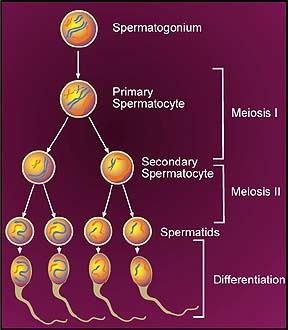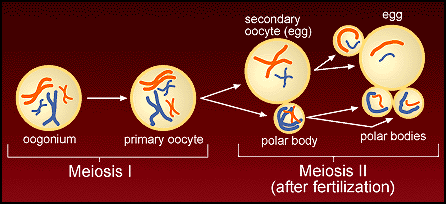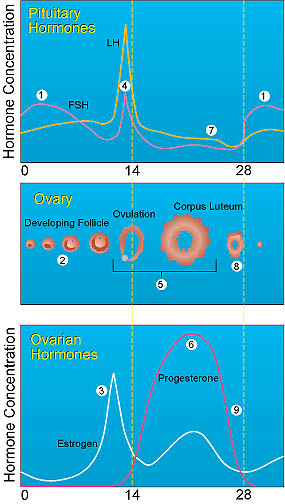
This part of the program will apply what you have learned concerning meiosis to living systems. Meiosis results in the formation of haploid cells which differentiate into gametes. In some of the lower organisms (Protista) the gametes are physically identical in size and shape, whereas in the more advanced organisms the gametes are not identical. Read pages indicated by G-14 and study behavioral objective 27. The life cycle of the protist Chlamydomonas (see figure) shows the formation of haploid reproductive cells which fuse together forming a zygote. Note that the reproductive cells (gametes) are physically identical. Draw this life cycle in your notes. These gametes are called isogametes. Reproductive cells produced in the human life cycle (see figure) are not physically identical. The female gamete is very large and non motile, whereas; the male gamete is very small and motile in animal organisms / non motile in higher plants organisms. These gametes are called heterogametes.
11. Which of the following statements is false?
a. Isogametes are always genetically identical.
b. Heterogametes
are haploid.
c. Heterogametes
are physically different.
d. Isogametes
are physically identical.
e. Isogametes
are haploid.
Press here to check answer. press
Gametogenisis is the process where meiosis followed by
differentiation produces the sex cells in higher animal organisms. This
process can be divided into spermatogenesis (formation of sperm)
and oogenesis (formation of ovum or egg). Read behavioral
objectives 28, 30, and 31. Study the pages indicated by G-15.
Examine the figure showing spermatogenesis. Notice that this process involves
both meiosis I and meiosis II. Draw this diagram in your notes and
identify the spermatogonia, primary spermatocyte, secondary spermatocyte,
spermatid, sperm. Indicate in your drawing where interphase, prophase I,
telophase I, telophase II are located.
k
The spermatognium can either divide by mitosis producing more spermatognium
or it may be stimulated to undergo meiosis in a step wise fashion forming
sperm (spermatogenesis).
12. Match the correct stage of meiosis I or II to the correct spermatogenesis term. Place this question in your notes. (hint: secondary spermatocyte consists of two cells; which stage of meiosis consisted of two cells)
A. Telophase meiosis II
1. spermatid
B. Prophase meiosis I
2. secondary spermatocyte
C. Telophase meiosis I
3. primary spermatocyte
D. Interphase meiosis I
4. spermatogonium
A
B
C
D
a. 1
4
2
3
b. 3
2
4
1
c. 1
3
2
4
d. 3
2
1
4
Press here to check answer. press
13. If the somatic body cells contain 46 chromosomes, how many
chromosomes would be located in the spermatid?
a. 2
c. 46
b. 23
d. 92
Press here to check answer. press
After spermatogenesis the spermatid differentiates into a sperm. Study behavioral objective 32 and read the pages indicated by G-16. In your notes draw a sperm cell (see below) and indicate the acrosome, nucleus, mitochondria and flagellum. Write a brief function for each of these structures.
k
Spermatogenesis is initiated by the hormone testosterone when the young male reaches puberty and continues throughout his life. In your notes draw the human male reproductive tract and identify the following: testis, seminiferous tubules, interstitial cells, epididymis, vas deferens, urethra. List a brief description for each of these structures.
This process is controlled by hormones. In your notes make a chart indicating where each of the following hormones are synthesized (hypothalamus, anterior pituitary, testis) and what list a function for each hormone.
Hormone
Site of Production Site of Action
Function
| GnRH | |||
| LN | |||
| FSH | |||
| Testosterone |
14. Name the gland which secretes fluids that are basic to neutralize
acidity of
vagina and contains factors that
enhance sperm motility.
a. urethra
b. testis
c. prostate
d. scrotum
Press here to check answer. press
15. Which structure produces testosterone.
a. urethra
b. testis
c. prostate
d. scrotum
Press here to check answer. press
16. Which structure in a sperm contains hydrolytic enzymes that will dissolve protective layers around the egg ?
a. flagellum
b. acrosome c. centrioles
d. mitochondrion
Press here to check answer. press
17. Which structure of the sperm provides energy for rapid movement?
a. flagellum
b. acrosome c. centrioles
d. mitochondrion
Press here to check answer. press
18. This male hormone is formed in the pituitary and stimulates testosterone production.
a. GNRH
b. FSH
c LH
d. estrogen
Press here to check answer. press
Read behavioral
objectives 29, 30, 34, and 36. Study the pages indicated by G-17.
Examine the figure showing oogenesis. See figure below. Notice that this
process involves both meiosis I and meiosis II. Draw this diagram in your
notes and identify the oogonium, primary oocyte, secondary oocyte,
polar bodies, ootid, egg or ovum. Note the differences between oogenesis
and spermatogenesis in that only one egg cell is produced during this process
and not four. The other three cells form polar bodies which are absorbed
and digested by the functional ootid.

The oogonia can either divide by mitosis producing more oogonia which than can grow into primary oocytes. Unlike spermatogenesis No oogonia remain after the third month of fetal development, and no new ones form during the rest of her life. All oogonia which are going to develop into egg cells are formed in the ovaries four months after conception. At birth each of the ovaries contain about a million primary oocytes. These cells remain at this stage (metaphase I) until puberty. At this time only a few oocytes resume meiosis during each moth of a female's reproductive span (puberty to metapause) forming haploid egg cells. Actually in humans meiosis II does not occur unless the primary oocyte is fertilized.
k
19. Match the correct stage of meiosis I or II to the correct oogenesis term.
A. Telophase meiosis II
1. ootid plus polar cells
B. Prophase meiosis I
2. secondary oocyte plus polar cell
C. Telophase meiosis I
3. primary oocyte
D. Interphase meiosis I
4. oogonium
A
B
C
D
a. 1
4
2
3
b. 3
2
4
1
c. 1
3
2
4
d. 3
2
1
4
Press here to check answer. press
20. If the somatic body cells contain 24 chromosomes, how
many chromosomes
would be located in the
ootid?
a. 2
c. 24
b. 12
d. 48
Press here to check answer. press
During oogenesis the secondary oocytes are ovulated from the ovary and move into the oviduct. Read the pages indicated by G-17. In your notes write a paragraph describing what occurs during the development and maturation primary oocytes and follicles and what occurs in the oviduct during fertilization and if fertilization does not occur.
In your notes draw the human female reproductive tract and identify the following: ovaries oviduct, uterus, endometrium tissue of uterus.
This process is controlled by hormones. In your notes make a chart indicating
where each of the following hormones are synthesized (hypothalamus, anterior
pituitary, corpus luteum,) and what list a function for each hormone.
Behavioral objective 36.
Hormone Site of Production Site of Action Function
| GnRH | |||
| LH | |||
| FSH | |||
| estrogen | |||
| progesterone |
Only one viable gamete (egg) is formed during oogenesis with the other three cells (polar bodies) being absorbed by the final cell (egg). Why do you think that only one egg is formed during oogenesis?
Compare your answer to the answer written below.
If four eggs were formed during oogenesis there would be multiple births (quadruple) instead of single births which would be difficult on the mother. Multiple births (twins, etc.) occur when the oogenesis process occurs two or more time during the same menstrual cycle.
21. The primary oocyte is :
a. diploid b. haploid
Press here to check answer. press
22. How many many eggs are produced by each oogonium?
a. 1 b. 2
c. 4 d. 8
Press here to check answer. press
23. The polar bodies are :
a. diploid b. haploid
Press here to check answer. press
Read pages indicated by G-18
and study behavioral
objective 35. In your notes explain the events that occur during
the menstrual cycle and explain how it is controlled by hormones.
(1)FSH and LH released by anterior pituitary causes (2) the follicles
to grow. (3)Estrogen produced by follicle cells causing the
continued growth of follicle, stimulating the endometrium of
uterus to grow and stimulating the pituitary to release LH and FSH
(4). The increase in LH stimulates meiosis to continue resulting
in the secondary oocyte and polar body. This culminates in ovulation(5).
(6) Corpus luteum secretes both estrogen and progesterone inhibiting
the pituitary and hypothalamus from releasing FSH and LH (7) which prevents
the development of more follicle. Corpus luteum breaks down due to lack
of LH (8). Estrogen and progesterone droop due to the absence of the corpus
luteum.(9).
k
24. This hormone is produced by the pituitary and
triggers the resumption of
meiosis and
culminates in ovulation.
a. FSH
b. LH
c. estrogen
d. progesterone
Press here to check answer. press
25. The primary hormone that inhibits GnRH is :
a. FSH
b. LH
c. progesterone
d. estrogen
Press here to check answer. press
This is the end of miniunit Gamma. Please return to the
home front page
. You may take the practice test for Gamma.
For information on how to use this page, go to How
to Use This Site.
Created by the Center for Learning Technologies, Academic Technology Services.
Last modified October 22, 1997.